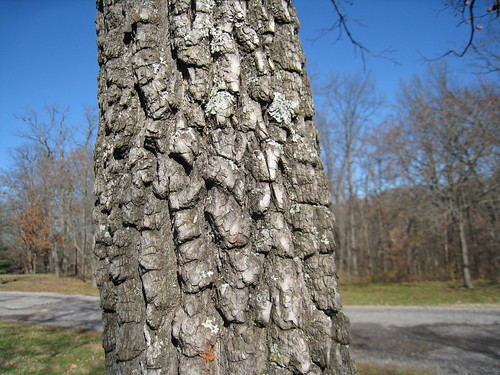 |
| My neighbor's mystery tree in early October. AMcC |
At first I thought of persimmon. The chunky, dark bark seemed right. The leaf seemed right, but where were the fruits? What is with that 45° turn about a third of way down most branches? It looks like each branch has a bent elbow with palms up, saying “I dunno.”
I suspected Black Gum, but thought of that as a swamp tree. These grew in soil that was average in moisture. I even looked with binoculars, searching for small berries without success. And I had read about Black Gum’s spectacular fall color, something that I had never noticed in these.
The mystery began to unravel when I read Don Kurz’ description of Black Gum’s bark as “alligator hide,” a description I had previously read applied to persimmon. He also mentions that Black Gum is “the first tree to turn color, typically beginning in August, and one of the first to drop its leaves” (Kurz, Trees of Missouri, 218). No wonder I had missed the autumn show! HortNet helped with the mystery of the invisible fruit. They note that only female trees bear fruit, the fruit blends with dark green leaves in summer, and any ripe fruit is quickly gobbled up by birds in late summer or early fall.
 |
| The Hebrew Moth, photo by Jenn Forman Orth |
Many sources describe spectacular red fall color. This is variable. Most trees in my neighborhood--now that I recognize them--have yellow leaves in fall. I saw one young tree however that had the most beautiful red leaves, and these persisted until late October.
Most often, Black Gum is a lowland tree, but not a tree of the swamps as I had thought. It's characteristic elbow branches are interesting in winter and a great help in identifying it.
Besides being a great nectar-producer in spring and fruiting tree for fall migrating birds, Black Gum is the host plant for an interesting underwing moth, called the Hebrew moth, Polygrammate hebraeicum. Heitzman, in Butterflies and Moths of Missouri mentions that the larvae “conceal themselves by pressing into crevices in the bark of the host plant” (263). My moth photo comes from Flickr friend Jenn Forman Orth. Check her original in full size along with a lively discussion about the origin of its name.
 |
| The "alligator-hide" bark of the Black Gum AMcC |
 |
| Bark of a young Flowering Dogwood forms squares AMcC |
 |
| Persimmon tree bark forms rectangles AMcC |
David Sibley, in The Sibley Guide to Trees, compares the bark of three similar trees. The related Flowering Dogwood has scaly bark in square blocks, the unrelated Persimmon’s bark is rectangular blocks, while Black Gum’s bark on mature trees is “deeply furrowed.” I see this not only on the trunk but also on large limbs. Perfect for hiding a caterpillar!
More mysteries to come in my next post…
Black gum is a super tree - the fall color is magnificent!
ReplyDeleteI agree. Almost all plants look great in spring, but a little planning is needed to have an interesting garden in fall & winter. Black Gum does it all!
ReplyDelete